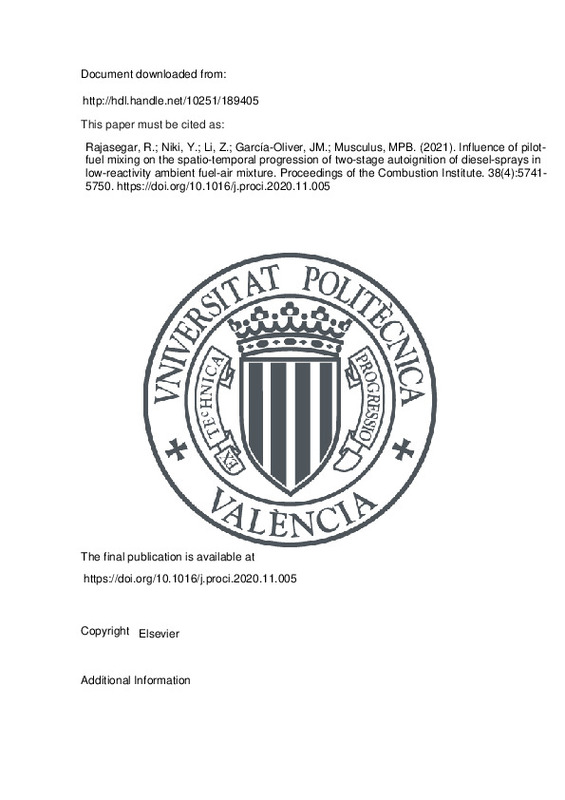JavaScript is disabled for your browser. Some features of this site may not work without it.
Buscar en RiuNet
Listar
Mi cuenta
Estadísticas
Ayuda RiuNet
Admin. UPV
Influence of pilot-fuel mixing on the spatio-temporal progression of two-stage autoignition of diesel-sprays in low-reactivity ambient fuel-air mixture
Mostrar el registro sencillo del ítem
Ficheros en el ítem
| dc.contributor.author | Rajasegar, Rajavasanth
|
es_ES |
| dc.contributor.author | Niki, Yoichi
|
es_ES |
| dc.contributor.author | Li, Zheming
|
es_ES |
| dc.contributor.author | García-Oliver, José M
|
es_ES |
| dc.contributor.author | Musculus, Mark P. B.
|
es_ES |
| dc.date.accessioned | 2022-11-07T19:02:08Z | |
| dc.date.available | 2022-11-07T19:02:08Z | |
| dc.date.issued | 2021 | es_ES |
| dc.identifier.issn | 1540-7489 | es_ES |
| dc.identifier.uri | http://hdl.handle.net/10251/189405 | |
| dc.description.abstract | [EN] The spatial and temporal locations of autoignition for direct-injection compression-ignition engines depend on fuel chemistry, temperature, pressure, and mixing trajectories in the fuel jets. Dual-fuel systems can provide insight into both fuel-chemistry and physical effects by varying fuel reactivities and engine operating conditions. In this context, the spatial and temporal progression of two-stage autoignition of a diesel-fuel surrogate, n-heptane, in a lean-premixed charge of synthetic natural-gas (NG) and air is imaged in an optically accessible heavy-duty diesel engine. The lean-premixed charge of NG is prepared by fumigation upstream of the engine intake manifold. Optical diagnostics include high-speed (15kfps) cool-flame chemiluminescenceimaging as an indicator of low-temperature heat-release (LTHR) and OH * chemiluminescence-imaging as an indicator high-temperature heat-release (HTHR). NG prolongs the ignition delay of the pilot fuel and increases the combustion duration. Zero-dimensional chemical-kinetics simulations provide further understanding by replicating a Lagrangian perspective for mixtures evolving along streamlines originating either at the fuel nozzle or in the ambient gas, for which the pilot-fuel concentration is either decreasing or increasing, respectively. The zero-dimensional simulations predict that LTHR initiates most likely on the air streamlines before transitioning to HTHR, either on fuel-streamlines or on air-streamlines in regions of near-constant phi. Due to the relatively short pilot-fuel injection-durations, the transient increase in entrainment near the end of injection (entrainment wave) is important for quickly creating auto-ignitable mixtures. To achieve desired combustion characteristics, e.g., multiple ignition-kernels and favorable combustion phasing and location (e.g., for reducing wall heat-transfer or optimizing charge stratification), adjusting injection parameters could tailor mixing trajectories to offset changes in fuel ignition chemistry. (C) 2020 The Combustion Institute. Published by Elsevier Inc. All rights reserved. | es_ES |
| dc.description.sponsorship | Support for this research at the Combustion Research Facility, Sandia National Laboratories, Livermore, CA, was provided by the U.S. Department of Energy (DOE), Office of Energy Efficiency and Renewable Energy. Sandia is a multi-mission laboratory operated by National Technology and Engineering Solutions of Sandia, LLC., a wholly owned subsidiary of Honeywell International, Inc., for the U.S. DOE's National Nuclear Security Administration under contract DE-NA0003525 | es_ES |
| dc.language | Inglés | es_ES |
| dc.publisher | Elsevier | es_ES |
| dc.relation.ispartof | Proceedings of the Combustion Institute | es_ES |
| dc.rights | Reconocimiento - No comercial - Sin obra derivada (by-nc-nd) | es_ES |
| dc.subject | Lean-premixed natural gas combustion | es_ES |
| dc.subject | Diesel | es_ES |
| dc.subject | Two-stage autoignition chemical kinetics | es_ES |
| dc.subject | Cool-flame imaging | es_ES |
| dc.subject | OH* chemiluminescence imaging | es_ES |
| dc.title | Influence of pilot-fuel mixing on the spatio-temporal progression of two-stage autoignition of diesel-sprays in low-reactivity ambient fuel-air mixture | es_ES |
| dc.type | Artículo | es_ES |
| dc.identifier.doi | 10.1016/j.proci.2020.11.005 | es_ES |
| dc.relation.projectID | info:eu-repo/grantAgreement/DOE//DE-NA0003525/ | es_ES |
| dc.rights.accessRights | Abierto | es_ES |
| dc.description.bibliographicCitation | Rajasegar, R.; Niki, Y.; Li, Z.; García-Oliver, JM.; Musculus, MPB. (2021). Influence of pilot-fuel mixing on the spatio-temporal progression of two-stage autoignition of diesel-sprays in low-reactivity ambient fuel-air mixture. Proceedings of the Combustion Institute. 38(4):5741-5750. https://doi.org/10.1016/j.proci.2020.11.005 | es_ES |
| dc.description.accrualMethod | S | es_ES |
| dc.relation.publisherversion | https://doi.org/10.1016/j.proci.2020.11.005 | es_ES |
| dc.description.upvformatpinicio | 5741 | es_ES |
| dc.description.upvformatpfin | 5750 | es_ES |
| dc.type.version | info:eu-repo/semantics/publishedVersion | es_ES |
| dc.description.volume | 38 | es_ES |
| dc.description.issue | 4 | es_ES |
| dc.relation.pasarela | S\435459 | es_ES |
| dc.contributor.funder | U.S. Department of Energy | es_ES |







![[Cerrado]](/themes/UPV/images/candado.png)

